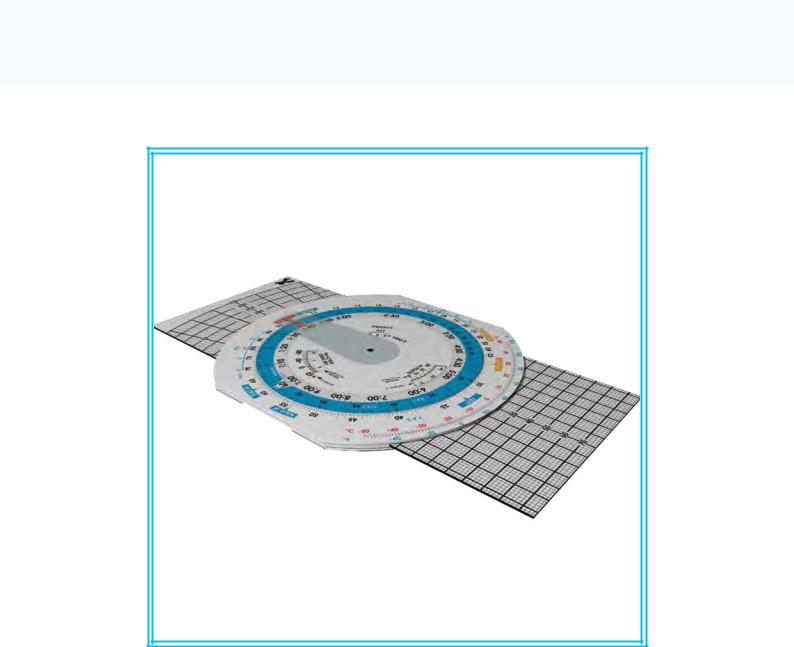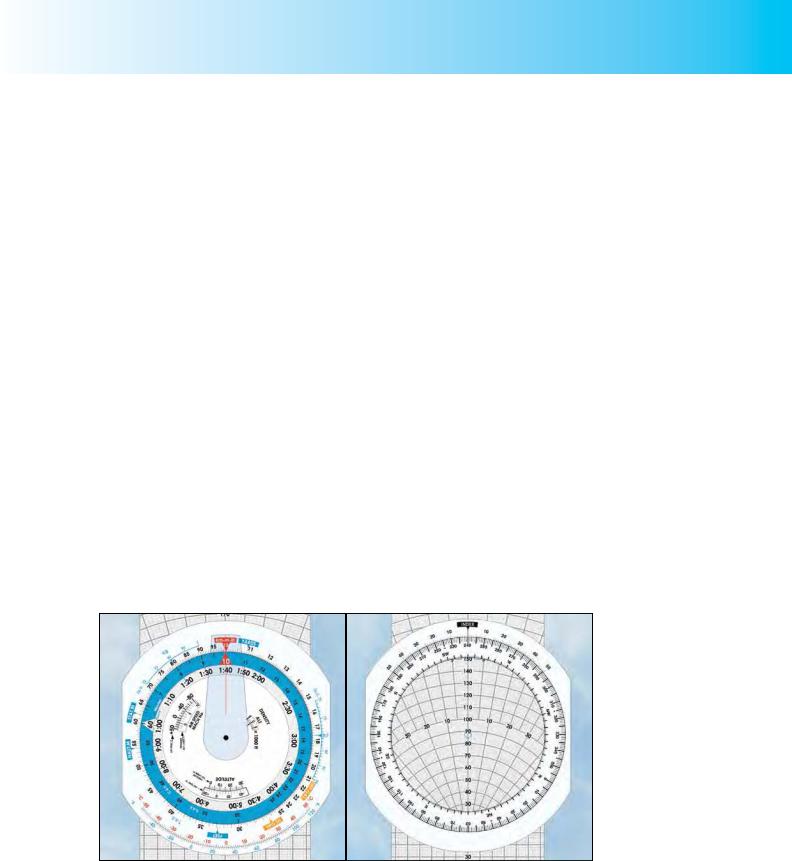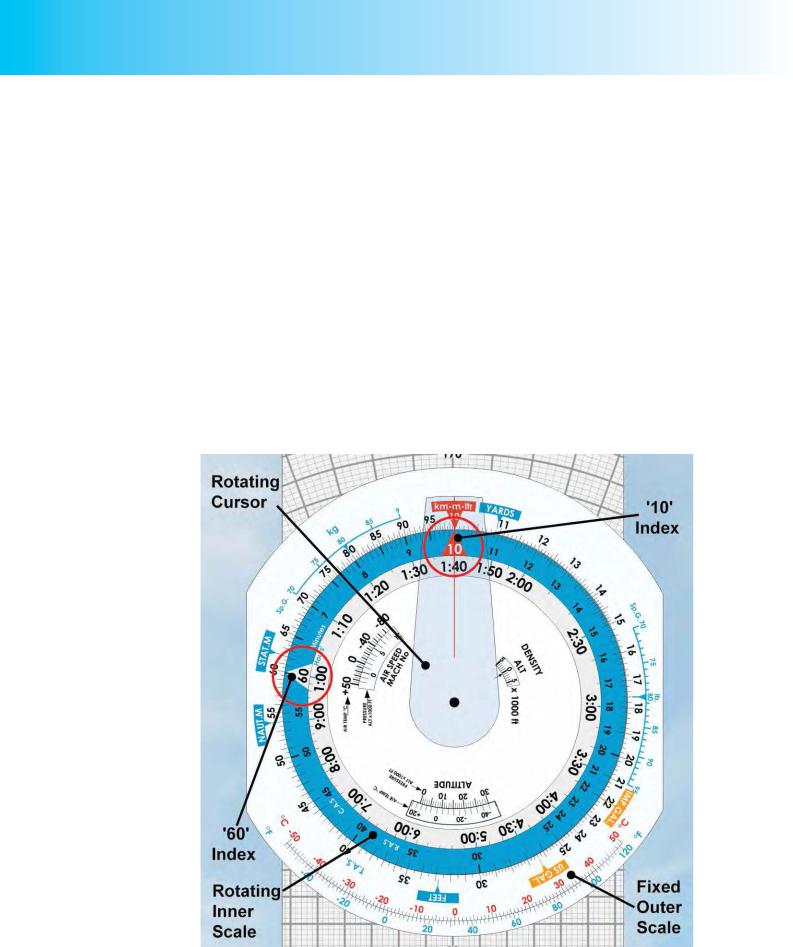
ppl_03_e2
.pdf
ID: 3658
Customer: Oleg Ostapenko E-mail: ostapenko2002@yahoo.com
Customer: Oleg Ostapenko E-mail: ostapenko2002@yahoo.com
CHAPTER 10: ALTIMETER SETTINGS
be sure to add the aerodrome elevation to all altimeter readings in the circuit in order to maintain the correct height above airfield level, at all times.
The air-ground radio operator may be able to pass an advisory QFE to the pilot. Pilots should, however, exercise caution when setting advisory QFE. The instruments from which air-ground radio operators obtain the QFE are often not regularly calibrated or otherwise checked. Of course, the VFR pilot should always be able to assess visually his separation from the ground.
ALTIMETER SETTING SUMMARY.
The table, below, is a summary of the altimeter subscale settings covered in this chapter, as they may apply to a VFR flight in a light aeroplane. The table contains details of the type of pressure datum set in the altimeter subscale, the term used to refer to the vertical distance associated with subscale setting, and when each setting is used.
ALTIMETER SUBSCALE |
VERTICAL |
|
WHEN USED |
SETTING |
DISTANCE FROM |
|
|
(PRESSURE DATUM) |
PRESSURE DATUM |
|
|
|
REFERRED TO AS |
|
|
Standard Pressure |
Flight Level |
• |
At or above the |
Setting, 1013.2 mb (hPa) |
|
|
transition altitude, |
|
|
|
the lowest useable |
|
|
|
Flight Level being |
|
|
|
known as the |
|
|
|
transition level. |
Aerodrome QNH |
Altitude |
• |
At or below the |
|
|
|
transition altitude. |
|
|
• |
When descending |
|
|
|
from a Flight Level |
|
|
|
unless ATC require |
|
|
|
further level reports. |
|
|
• |
At the pilot’s |
|
|
|
discretion, on final |
|
|
|
approach. |
QFE |
Height |
• |
Normally, in the |
|
|
|
circuit and on final |
|
|
|
approach. |
Regional Pressure |
Altitude |
• |
At or below the |
Setting |
|
|
transition altitude, |
|
|
|
when not in the |
|
|
|
vicinity of a major |
|
|
|
aerodrome or under |
|
|
|
a CTA or TMA. |
167

Order: 6026
Customer: Oleg Ostapenko E-mail: ostapenko2002@yahoo.com
Customer: Oleg Ostapenko E-mail: ostapenko2002@yahoo.com
CHAPTER 10: ALTIMETER SETTINGS QUESTIONS
Representative PPL - type questions to test your theoretical knowledge of Altimeter Settings.
1.You are flying above the Transition Altitude with 1013 mb (hPa) set on the altimeter which is reading 6 000 feet. What is your Flight Level (FL)?
a.FL6
b.FL006
c.FL60
d.FL600
2.You are on the apron of an aerodrome and ask ATC for the aerodrome QFE which you then set on the altimeter. Would your altimeter then read zero feet?
a.Yes
b.Not necessarily, since QFE is measured from a standard pressure setting
c.Not necessarily, since QFE is measured from the Aerodrome Reference Point which may not be coincident with the apron
d.There is no location on the aerodrome, where the altimeter would read zero
3.You are on the apron of an aerodrome and ask ATC for the aerodrome QNH which you then set on the altimeter. Which of the following should your altimeter reading indicate?
a.Height
b.Vertical distance above the SPS
c.Zero feet
d.The apron elevation
4.What is the Standard Pressure Setting?
a.QNH
b.QFE
c.Zero feet
d.1013.2 millibars or 1013.2 hectopascals
5.You fly from an aerodrome of a given atmospheric pressure to a destination aerodrome where the atmospheric pressure is significantly lower than at your point of departure. If you fly the route at a constant altimeter reading, what would be the path of your aircraft in terms of its vertical separation from the ground?
a.It would climb as you approach your destination
b.It would descend as you approach your destination
c.It would remain at the same height above the ground
d.It would remain at the same vertical distance above mean sea-level
168

ID: 3658
Customer: Oleg Ostapenko E-mail: ostapenko2002@yahoo.com
Customer: Oleg Ostapenko E-mail: ostapenko2002@yahoo.com
CHAPTER 10: ALTIMETER SETTINGS QUESTIONS
6.What is QFE?
a.The pressure setting at the aerodrome reference point, normally the highest point on the landing area
b.The pressure setting at the aerodrome reference point, reduced to sea level
c.The pressure setting of the altimeter in the ATC Tower
d.The pressure setting at the lowest point on the aerodrome
7.What is the Transition Altitude at most aerodromes in the United Kingdom?
a.2 000 feet
b.3 000 feet
c.5 000 feet
d.18 000 feet
8.If a pilot is to carry out circuit practice at an aerodrome, what is the most practical and appropriate pressure setting for the altimeter?
a.QFE
b.1013 mb (hPa)
c.The Standard Pressure Setting
d.The Regional Pressure Setting
9.If you are to fly a cross-country route below the transition altitude, what is the most appropriate pressure setting for your altimeter when you have left the immediate vicinity of your departure aerodrome?
a.QFE
b.Regional Pressure Setting provided you are not still beneath a CTA or TMA
c.Standard Pressure Setting
d.1013 mb (hPa)
10.You are flying en-route below the Transition Altitude. How must you report your aircraft’s vertical position to an Air Traffic Service Unit?
a.As a Flight Level
b.As a height
c.As an altitude
d.As an elevation
11.What is defined as the “first available Flight Level above the Transition
Altitude”?
a.Transition Layer
b.Transition Elevation
c.Transition Level
d.Transition Height
169

Order: 6026
Customer: Oleg Ostapenko E-mail: ostapenko2002@yahoo.com
Customer: Oleg Ostapenko E-mail: ostapenko2002@yahoo.com
CHAPTER 10: ALTIMETER SETTINGS QUESTIONS
12.What is the Transition Layer?
a.The vertical distance between a given Flight Level and the Transition Level
b.The vertical distance between the Transition Altitude and the Transition Level
c.The vertical distance from the ground to the Transition Altitude
d.The vertical distance from the Aerodrome Reference Point (ARP) to the Transition Altitude
13.An altimeter reading from an aircraft in the air, based on aerodrome QFE is reported as:
a.Elevation
b.Altitude
c.Height
d.Flight Level
14.The reading of an altimeter, in flight, with QNH set on its subscale is known as:
a.Flight Level
b.Altitude
c.Height
d.Elevation
15.Which of the four options below gives the most accurate definition of
“transition altitude”?
a.The altitude at or above which the vertical position of an aircraft is monitored by reference to altitude
b.The altitude at or below which the vertical position of an aircraft is monitored by reference to altitude
c.The altitude at or above which the vertical position of an aircraft is monitored by reference to height
d.The altitude at or below which the vertical position of an aircraft is monitored by reference to height
16.What pressure setting should be entered on the altimeter subscale of an aircraft which is descending to below the transition level prior to commencing
avisual approach to a non-military aerodrome?
a.The Regional Pressure Setting
b.The Standard Pressure Setting
c.The Aerodrome QFE
d.The Aerodrome QNH
170

ID: 3658
Customer: Oleg Ostapenko E-mail: ostapenko2002@yahoo.com
Customer: Oleg Ostapenko E-mail: ostapenko2002@yahoo.com
CHAPTER 10: ALTIMETER SETTINGS QUESTIONS
17.Complete the following sentence. While passing through the transition layer, vertical separation from the appropriate pressure datum level should be expressed as ______ when climbing and ______ when descending.
a. |
Flight Level |
Altitude |
b. |
Height |
Altitude |
c. |
Flight Level |
Height |
d. |
Height |
Flight Level |
18.A VFR pilot is cruising, en-route, in level flight, above the transition level of
FL35. His magnetic heading is 355º, and he sees that by having allowed for 8º of starboard drift he is exactly on track. What would be an appropriate Flight Level for the pilot to choose in accordance with the Quadrantal Rule?
a.FL40
b.FL45
c.FL50
d.FL55
19.A pilot setting off on a cross-country route in a cruise climb over a part of the country where the transition altitude is 3000 feet, has just been given
aRegional Pressure Setting of 970 mb (hPa), from a local ATSU. His magnetic track is 260º. What will be the transition level and what will be lowest available Flight Level that the pilot can use, in accordance with the Quadrantal Rule? (Note: assume that pressure falls with increasing height by 1 mb every 30 feet)
a. |
FL 45 |
FL 60 |
b. |
FL 40 |
FL 55 |
c. |
FL 30 |
FL 30 |
d. |
FL 45 |
FL 55 |
20.A pilot, who has just left the ATZ of the departure aerodrome and has set off on a cross-country route, is flying beneath a Terminal Control Area (TMA).
What pressure setting should he have on his altimeter subscale?
a.The destination aerodromes QFE
b.The Regional Pressure Setting
c.The departure aerodrome’s QFE
d.The QNH of an aerodrome beneath the TMA
21.You are flying above the transition level, on a VFR cross-country flight in a light aircraft, following a magnetic track of 180º. You refer to the Quadrantal Rule to decide what Flight Level to cruise at. With your altimeter subscale set at 1013 mb (hPa), you should choose:
a.Odd thousands of feet
b.Even thousands of feet
c.Even thousands of feet plus 500
d.Odd thousands of feet plus 500
171

Order: 6026
Customer: Oleg Ostapenko E-mail: ostapenko2002@yahoo.com
Customer: Oleg Ostapenko E-mail: ostapenko2002@yahoo.com
CHAPTER 10: ALTIMETER SETTINGS QUESTIONS
22.The transition altitude for civil aerodromes in the United Kingdom is:
a.5 000 feet amsl
b.3 000 feet amsl unless otherwise notified, for example for the
Scottish, Manchester and London TMAs
c.4 500 feet amsl
d.3 000 feet amsl
Question |
1 |
2 |
3 |
4 |
5 |
6 |
7 |
8 |
9 |
10 |
11 |
12 |
|
|
|
|
|
|
|
|
|
|
|
|
|
|
|
Answer |
|
|
|
|
|
|
|
|
|
|
|
|
|
|
|
|
|
|
|
|
|
|
|
|
|
|
|
Question |
13 |
14 |
15 |
16 |
17 |
18 |
19 |
20 |
21 |
22 |
|
|
|
|
|
|
|
|
|
|
|
|
|
|
|
|
|
Answer |
|
|
|
|
|
|
|
|
|
|
|
|
|
The answers to these questions can be found at the end of this book.
172

Customer: Oleg Ostapenko E-mail: ostapenko2002@yahoo.com
CHAPTER 11
THE NAVIGATION COMPUTER
173

Order: 6026
Customer: Oleg Ostapenko E-mail: ostapenko2002@yahoo.com
Customer: Oleg Ostapenko E-mail: ostapenko2002@yahoo.com
CHAPTER 11: THE NAVIGATION COMPUTER
CONVERSION TABLE FOR VOLUMES, WEIGHT & DISTANCES.
FLUIDS.
1 |
Imperial gallon |
= |
4.55 litres |
= |
1.2 US gallons |
1 litre |
= |
0.22 Imperial gallons |
= |
0.264 US gallons |
|
1 |
US gallon |
= |
0.83 Imperial gallons |
= |
3.8 litres |
WEIGHTS.
1 Imperial gallon of water weighs 10 pounds (lb)
1 litre of water weighs 1 kilogram (kg)
1 US gallon of water weighs 8.3 lb
1 kg |
= |
2.2 lb |
1 lb |
= |
0.454 kg |
Specific gravity of AVGAS = 0.72 |
||
DISTANCES.
1 metre |
= |
3.28 feet |
= |
1.1 yards |
|
|
1 inch |
= |
2.54 centimetres |
|
|
|
|
1 nautical mile |
= |
1.15 statute miles |
= |
1.85 kilometres |
= |
6080 feet |
1 kilometre |
= |
0.54 nautical miles |
= |
0.62 statute miles |
= |
3280 feet |
1 statute mile |
= |
0.87 nautical miles |
= |
1.61 kilometres |
= |
5280 feet |
1 metre/second |
= |
1.94 knots |
= 197 feet per minute |
|
|
|
174

ID: 3658
Customer: Oleg Ostapenko E-mail: ostapenko2002@yahoo.com
Customer: Oleg Ostapenko E-mail: ostapenko2002@yahoo.com
CHAPTER 11: THE NAVIGATION COMPUTER
INTRODUCTION.
In Chapter 9, you learnt the theory of how drift angle, heading to fly and groundspeed are calculated from first principles through the construction of a triangle of velocities.
We could, if we wished, construct a triangle of velocities for every navigation leg we planned to fly, provided that we have measured the true bearing of the route, decided on an indicated airspeed at which to fly the route, converted that indicated airspeed to a true airspeed, and obtained an accurate wind forecast.
To carry out our navigation calculations in such a way would, however, be impractical and time consuming. It is fortunate therefore that modern pilots have a choice of computers to help them with their pre-flight planning. Computers are nowadays invariably electronic digital machines, but older analogue computers, based on the principle of the slide-rule, still have their use. A computer is literally any device which can perform calculations, and one of the most reliable navigation computers is the circular/slide-type computer, sometimes known as the “whiz wheel,” that all student pilots preparing for ground examinations must still be able to use fluently.
There are numerous types of the circular/slide-type navigation computer on the market, produced by companies such as Pooley’s, Airplan Flight Equipment, Transair, Jeppesen, etc. All of them work on the same principle, and all of them allow pilots to carry out, quickly and accurately, navigation problems, involving the triangle of velocities, the calculation of true airspeed, fuel consumption, endurance, track error, and so on. All whiz-wheel navigation computers derive ultimately from the Dalton Computer developed by Philip Dalton of the United States Navy, in the late 1930s.
Oxford Aviation Academy has produced a training CD-ROM for this type of navigation computer which aims to teach you every one of the computer’s functions, and which incorporates a fully-functional, virtual Dalton-type computer. The CD-ROM is included with this book. (See Figure 11.1.)
Figure 11.1 The Dalton-type navigation computer.
For the mental dead reckoning method of visual navigation that a student is required to learn in order to gain a private pilot’s licence, the Dalton-type analogue navigation computer is an excellent teaching device, as well as a calculator.
175

Order: 6026
Customer: Oleg Ostapenko E-mail: ostapenko2002@yahoo.com
Customer: Oleg Ostapenko E-mail: ostapenko2002@yahoo.com
CHAPTER 11: THE NAVIGATION COMPUTER
By mastering this type of instrument, in order to calculate drift and headings, pilots learn how to visualise what dead reckoning navigation is all about.
In fact, skill in the use of the Dalton-type navigation computer is thought to be so important to the training of the modern pilot-navigator that it is still (in 2007) the only navigation computer that may be used in the formal examinations set by the majority of national aviation authorities.
Thus, every student pilot must become proficient in the use of the Dalton-type computer. The CD-ROM will introduce you to the computer and teach you all that you need to know about its functions; but for quick reference purposes, the main operations that a pilot is required to work out on the computer are covered in this chapter.
THE CONSTRUCTION AND APPEARANCE OF THE COMPUTER.
Actual, branded Dalton-type computers vary slightly in the detail of their layout compared to the one shown in our illustrations, but their main features are very similar and their principle of operation is the same in all cases. You will probably find that the computer you are using looks very much like the instrument depicted in this chapter.
Figure 11.2 The Circular Slide Rule Face of the Dalton-type navigation computer, featured in
Oxford Aviation Training’s CD-ROM.
176
